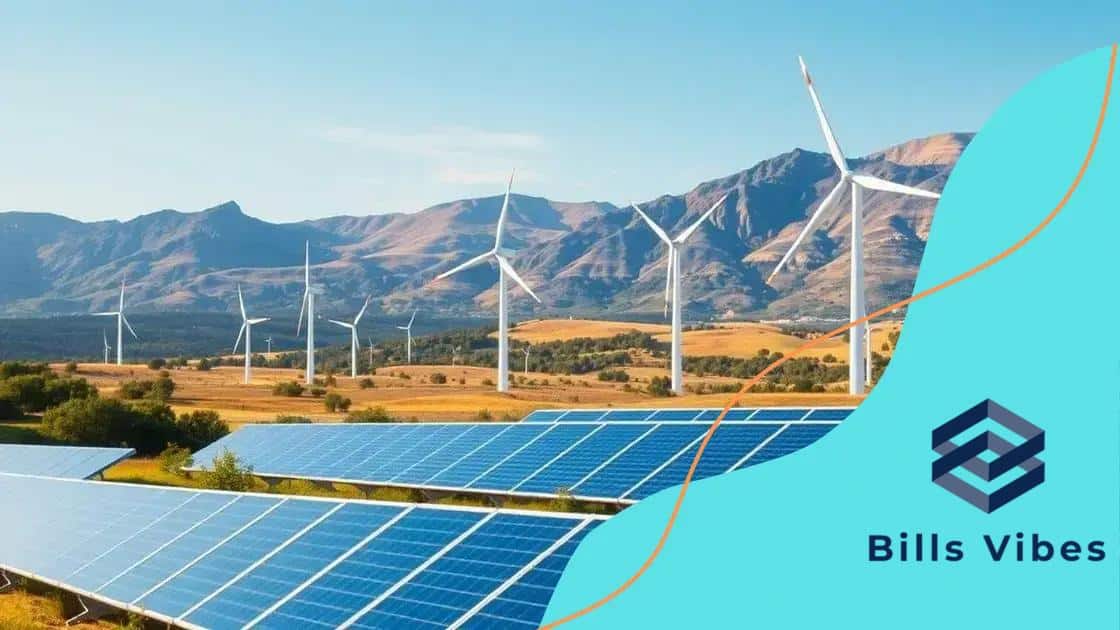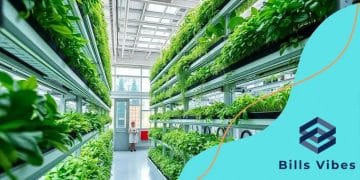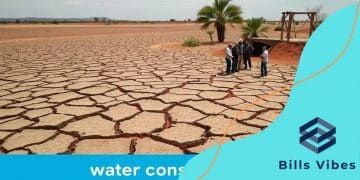Renewable energy breakthroughs transforming our future

Challenges in adopting renewable technologies include high initial costs, public perception issues, and regulatory barriers, which hinder the transition to sustainable energy solutions.
Renewable energy breakthroughs are changing the way we generate power and interact with our environment. Have you ever wondered how these innovations can impact our daily lives and the planet’s health? Let’s dive into this important topic.
Understanding renewable energy breakthroughs
Understanding renewable energy breakthroughs is essential in our journey toward a sustainable future. These innovations not only help reduce carbon emissions but also provide us with cleaner, more reliable energy sources.
Types of Renewable Energy Breakthroughs
There are several key areas where breakthroughs are making a significant impact in renewable energy. From solar to wind, each technology brings unique advantages. Here are some examples:
- Solar Energy: Innovations in solar panel efficiency are allowing for more energy capture with less space.
- Wind Energy: Advanced turbine designs enhance energy generation, even in low-wind conditions.
- Energy Storage: Progress in battery technology means we can store renewable energy for later use, making it a more viable option for everyday consumption.
- Bioenergy: New methods of converting organic materials into fuel are reducing waste and providing alternative energy sources.
These breakthroughs show how technology and creativity can transform energy production. For instance, solar farms are now utilizing dual-sided panels to capture more sunlight, further enhancing their efficiency. Meanwhile, offshore wind farms are emerging as powerhouses that harness the energy of ocean winds, often generating more electricity than traditional onshore farms.
In addition, the integration of smart grids allows for better distribution and management of energy resources. This interconnected system optimizes energy flow, balancing supply and demand efficiently. It’s an exciting time for renewable energy breakthroughs, as researchers and engineers constantly innovate to improve and expand these technologies.
Recent advancements in solar technology
Recent advancements in solar technology are transforming how we harness energy from the sun. These innovations not only improve energy efficiency but also make solar power more accessible to everyone.
Enhanced Solar Panel Efficiency
One of the key breakthroughs in solar technology is the significant increase in panel efficiency. Modern solar panels are now capable of converting more sunlight into electricity, often exceeding 22% efficiency. This means more energy production from the same amount of sunlight, which is crucial for maximizing energy output.
- Perovskite Solar Cells: These new materials are cheaper and easier to manufacture, promising better performance than traditional silicon cells.
- Bifacial Panels: These panels can capture sunlight on both sides, increasing energy generation without requiring additional space.
- Tracking Systems: Solar panels that follow the sun throughout the day can boost energy capture significantly.
Moreover, the integration of smart technology allows solar systems to operate more efficiently. With smart inverters, users can monitor energy production in real-time, optimizing their energy usage. This not only saves money but also ensures that solar energy is utilized to its fullest potential.
The installation process has also become simpler with advancements in mounting technologies. Innovations such as solar shingles are being developed, which blend seamlessly into rooftops and provide energy generation without compromising aesthetics. These designs are appealing to homeowners, making solar adoption more attractive.
As we continue to innovate, the future of solar technology looks promising, with breakthroughs paving the way for more widespread adoption and integration into our energy systems. Harnessing the sun’s power is becoming easier and more efficient every day, contributing significantly to our sustainable energy goals.
Innovations in wind energy

Innovations in wind energy are reshaping the way we harness the power of the wind. These advancements enhance energy efficiency and production, making wind a key player in sustainable energy strategies.
Advanced Turbine Designs
New turbine designs are leading the charge in improving wind energy generation. Modern turbines are taller and equipped with larger blades, which capture more wind, regardless of its speed. This results in increased energy production and better efficiency.
- Vertical Axis Wind Turbines: These turbines have a unique design that allows them to capture wind from any direction, making them versatile and suitable for urban environments.
- Offshore Wind Farms: Located in bodies of water, these farms benefit from stronger and more consistent winds, driving significant energy output.
- Smart Wind Turbines: Equipped with sensors and IoT technology, these turbines maximize performance by adjusting to changing wind conditions automatically.
The use of robotics in maintaining and inspecting wind turbines is another exciting development. Drones can perform regular checks on offshore turbines, ensuring they operate efficiently and reducing maintenance costs. This is a game-changer, especially in hard-to-reach locations.
In addition to technology enhancements, community involvement is growing. Many local governments are now partnering with renewable energy companies to develop wind farms. This allows communities to benefit from clean energy and economic growth, creating jobs and fostering sustainability.
The future of wind energy is bright, with continuous innovations pushing boundaries. As these technologies develop, they promise to make wind energy more reliable, economical, and essential in our pursuit of a clean energy future.
The role of geothermal energy
The role of geothermal energy in our energy landscape is increasingly significant. This renewable energy source harnesses heat from beneath the Earth’s surface, providing a stable and sustainable power option.
How Geothermal Energy Works
Geothermal energy systems use steam or hot water from the Earth to generate electricity or heat buildings. This process starts by drilling wells deep into the ground to access the hot water or steam reservoirs. Once the heat is brought to the surface, it can be used in several ways.
- Electricity Generation: In geothermal power plants, steam drives turbines that produce electricity.
- Direct Use Applications: This includes heating buildings, growing plants in greenhouses, or drying crops.
- Geothermal Heat Pumps: These systems use shallow ground to heat and cool buildings efficiently.
The reliability of geothermal energy is one of its strongest features. Unlike solar or wind energy, which depend on weather conditions, geothermal energy can provide consistent output, 24/7. This stability makes it an excellent complement to other renewable energy sources, helping to provide a balanced energy portfolio.
Countries like the United States, Iceland, and the Philippines lead in utilizing geothermal energy. In Iceland, nearly 90% of homes are heated using this renewable resource, showcasing its effectiveness and reliability. Furthermore, as technology advances, access to geothermal resources continues to improve, expanding its potential beyond traditional regions.
Geothermal energy’s low emissions make it an attractive option in our fight against climate change. By reducing our reliance on fossil fuels and integrating more geothermal solutions, we can work toward a healthier planet.
Challenges in adopting renewable technologies
Challenges in adopting renewable technologies are significant, but understanding them is crucial for progress. These challenges can slow down the transition to cleaner energy solutions, impacting both policy and public engagement.
Financial Barriers
One of the major hurdles is the high initial investment cost. Many renewable technologies, such as solar panels and wind turbines, require significant upfront capital. While prices have decreased over time, the expense can still be a barrier for both individuals and businesses.
- Subsidy Dependence: Many renewable projects rely heavily on government incentives, which may fluctuate with political changes.
- Financing Gaps: Not all renewable projects qualify for favorable financing options, making it tough for developers to secure necessary funding.
- Market Volatility: Fluctuating prices for fossil fuels can make renewable energy seem less attractive, causing some investors to hesitate.
In addition to financial barriers, technology maturity plays a key role in adoption. Some renewable technologies are still developing, which can lead to concerns about performance, reliability, and long-term durability. Early adopters often face challenges like limited availability of components and higher maintenance costs.
Public perception can also affect the adoption of renewable solutions. Misunderstandings about how renewable technologies work can lead to resistance. Some people may fear changes due to misinformation about costs, efficiency, or environmental impact. Education and outreach are essential to dispel these myths and foster acceptance.
Lastly, regulatory and logistical issues can complicate the deployment of renewable technologies. Existing infrastructure may not support new installations easily, and bureaucratic processes can slow down project implementation. Streamlining approval processes and adapting regulations can help mitigate these challenges.
FAQ – Frequently Asked Questions about Renewable Technologies
What are the main challenges in adopting renewable technologies?
Challenges include high initial costs, public perception issues, and regulatory hurdles that can slow down adoption.
How does community engagement help in the adoption of renewables?
Community involvement fosters support and spreads awareness, making it easier to launch and sustain renewable energy projects.
Why is public education important for renewable technologies?
Educating the public helps dispel myths and misunderstandings, leading to greater acceptance and adoption of renewable solutions.
What role does government support play in renewable adoption?
Government support through incentives and regulations can significantly enhance the viability and attractiveness of renewable technologies.






